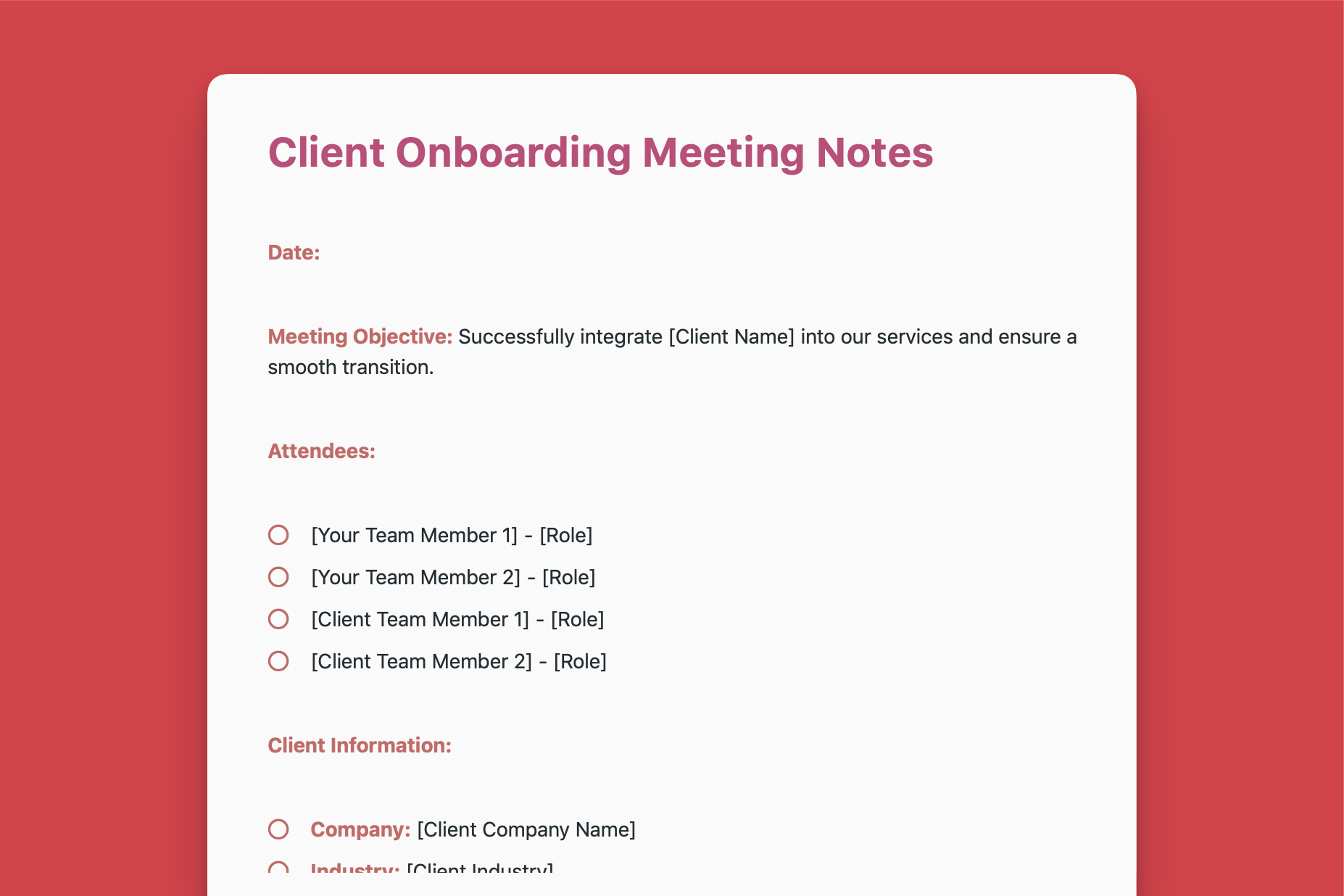Home

Client Onboarding
A detailed NotePlan template for organizing and documenting client onboarding meetings, ensuring a smooth transition and successful project outcomes.
Get things done with NotePlan
Categories
This comprehensive NotePlan template is designed to streamline the client onboarding process, ensuring a seamless transition and fostering a strong client relationship from day one. By providing a structured format for documenting key information, discussions, and action items, this template ensures that all stakeholders are aligned, expectations are clear, and the project progresses smoothly toward success.
Meeting Details:
- Date: Record the date of the onboarding meeting for future reference.
- Meeting Objective: Clearly state the primary goal of the meeting, which is typically to successfully integrate the new client into your services and establish a solid foundation for a long-lasting partnership.
Attendees:
- Your Team: List all team members from your organization who are participating in the meeting, along with their roles (e.g., project manager, account manager, technical lead).
- Client Team: Include all individuals from the client's side who are attending, along with their roles (e.g., decision-maker, primary contact, technical representative).
Client Information:
- Company: Note the official name of the client's company.
- Industry: Specify the industry in which the client operates.
- Main Point of Contact: Clearly identify the individual who will serve as the primary liaison between your team and the client.
- Contact Information: Record the email address and phone number of the main point of contact for easy communication.
Client Needs and Expectations:
- This section is crucial for understanding the client's unique requirements, goals, and desired outcomes from your services. Document these in detail, ensuring that you capture both explicit and implicit expectations.
- Consider asking probing questions to uncover any underlying needs or challenges that the client may be facing.
Project Scope:
- Clearly define the scope of work that will be undertaken for the client. This includes a detailed breakdown of the services you will provide, deliverables, and any limitations or exclusions.
- A well-defined project scope helps manage expectations, prevent scope creep, and ensure that both parties are aligned on the project's parameters.
Timeline and Milestones:
- Develop a comprehensive timeline that outlines key project phases, milestones, and their associated due dates. This serves as a roadmap for the onboarding process, ensuring that both teams have a shared understanding of the project's trajectory.
- Indicate which party (your team or the client) is responsible for each milestone, promoting accountability and ownership.
- Include a "Notes" column to capture any relevant details, contingencies, or potential roadblocks for each milestone.
Roles and Responsibilities:
- Clearly assign roles and responsibilities for each task or aspect of the project. This ensures that everyone knows their part in the process and avoids confusion or duplication of effort.
- Consider using a RACI matrix (Responsible, Accountable, Consulted, Informed) to further clarify roles and communication channels.
- Include a "Notes" column to capture any specific instructions, dependencies, or additional information related to each task.
Communication Plan:
- Establish a communication plan that outlines how often and through which channels (email, phone, video call, project management software) communication will occur between the two teams.
- Regular communication is essential for keeping everyone informed of progress, addressing issues promptly, and maintaining a positive working relationship.
Budget:
- Document the estimated budget for the onboarding process, including any potential additional costs or contingencies.
- Transparency regarding budget fosters trust and helps the client plan their resources effectively.
Next Steps:
- Clearly outline the immediate actions that need to be taken following the meeting to initiate the onboarding process. This may include scheduling follow-up meetings, gathering necessary information, or assigning initial tasks.
- Assigning ownership and due dates for these next steps ensures that momentum is maintained and progress continues.